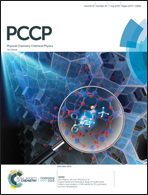Solvation free energies via alchemical simulations: let's get honest about sampling, once more†
Abstract
Free energy perturbation (FEP) approaches with stratification have seen widespread and increasing use in computational studies of biologically relevant molecules. However, when the molecular systems are characterized by a complex conformational free energy landscape, the assessment of convergence remains a concern for many practitioners. The sampling problem in FEP has been authoritatively addressed in a recent perspective paper [D. Mobley, J. Comput.-Aided Mol. Des., 2012, 26, 93], incisively entitled “Let's get honest about sampling”. Here, I return to the issue of sampling in the determination of the octanol–water partition coefficient for a synthetic precursor of kinase inhibitors that has been included in the recent extension of the SAMPL6 blind challenge of log P coefficients. I will show that even for this simple compound, whose conformational space is essentially dictated by two sp3 rotable bonds connecting rigid planar units, canonical sampling using standard techniques can be surprisingly hard to achieve. I will also show how the conformational sampling problem can be effectively bypassed using unidirectional and bidirectional nonequilibrium work methods, reliably recovering the solvation energy with minimal methodological uncertainty.



 Please wait while we load your content...
Please wait while we load your content...